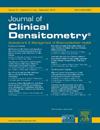伴有神经肌肉连接处退化的漏肠界面;对严重肌肉减少症的影响
IF 1.6
4区 医学
Q4 ENDOCRINOLOGY & METABOLISM
引用次数: 0
摘要
导读:肠通透性或漏肠的病理增加最近与年龄相关的肌肉损失的发病机制有关,称为肌肉减少症。然而,相关的肌毒性作用尚不清楚。我们研究了在老年人严重肌肉减少症和功能损害的情况下,漏肠与神经肌肉接头(NMJ)退化的关系。方法:本研究纳入对照组(n=161,年龄=73.4±8.5岁)和重度肌少症男性(n=148,年龄=72.4±7.2岁),测量漏肠血浆标志物(zonulin)、NMJ降解(CAF22)和细菌负荷(脂多糖结合蛋白;LBP)。我们还分别测量了握力(HGS)、步态速度和短物理性能电池(SPPB)作为肌肉减少和功能损害的标志。结果:重度肌少症患者血浆zonulin、CAF22和LBP水平高于对照组,HGS、步态速度和SPPB评分低于对照组(p < 0.05)。我们发现血浆zonulin和CAF22在对照组和严重肌少症男性中存在显著相关性(p < 0.05)。存在严重的肌肉减少症和SPPB评分<;9例与zonulin与CAF22相关性增强相关(p < 0.05)。较高的血浆zonulin和CAF22与较高的血浆LBP、较低的HGS和步态速度以及较低的SPPB评分相关(均p < 0.05)。结论:肠道渗漏引起的严重肌肉减少症和功能损害可能与NMJ降解和血浆细菌负荷升高有关。未来的研究应该建立肠道渗漏和老年肌肉减少症之间的因果关系和机制联系。本文章由计算机程序翻译,如有差异,请以英文原文为准。
The interface of a leaky gut with neuromuscular junction degradation; implications for severe sarcopenia
Introduction: A pathological increase in intestinal permeability or leaky gut is recently implicated in the pathogenesis of age-associated muscle loss, termed sarcopenia. However, the associated myotoxic effects are poorly known. We investigated the associations of a leaky gut with neuromuscular junction (NMJ) degradation in the context of severe sarcopenia and functional compromise in older adults.
Methodology: This study includes controls (n=161, age=73.4±8.5 years) and severe sarcopenic men (n=148, age=72.4±7.2 years) for measurements of plasma markers of a leaky gut (zonulin), NMJ degradation (CAF22), and bacterial load (lipopolysaccharides-binding protein; LBP). We also measured handgrip strength (HGS), gait speed, and short physical performance battery (SPPB) as sarcopenic and functional compromise markers, respectively.
Results: Severe sarcopenic patients had higher plasma zonulin, CAF22, and LBP levels and lower HGS, gait speed, and SPPB scores than controls (all p<0.05). We found significant correlations between plasma zonulin and CAF22 in controls and severe sarcopenic men (both p<0.05). The presence of severe sarcopenia and SPPB scores < 9 were associated with strengthening the correlation between zonulin and CAF22 (p<0.05). Higher plasma zonulin and CAF22 were associated with higher plasma LBP, lower HGS and gait speed, and lower SPPB scores (all p<0.05).
Conclusion: Collectively, severe sarcopenia and functional compromise due to intestinal leak may involve NMJ degradation and higher plasma bacterial load. Future studies should establish the causal and mechanistic associations between intestinal leak and sarcopenia in old age.
求助全文
通过发布文献求助,成功后即可免费获取论文全文。
去求助
来源期刊

Journal of Clinical Densitometry
医学-内分泌学与代谢
CiteScore
4.90
自引率
8.00%
发文量
92
审稿时长
90 days
期刊介绍:
The Journal is committed to serving ISCD''s mission - the education of heterogenous physician specialties and technologists who are involved in the clinical assessment of skeletal health. The focus of JCD is bone mass measurement, including epidemiology of bone mass, how drugs and diseases alter bone mass, new techniques and quality assurance in bone mass imaging technologies, and bone mass health/economics.
Combining high quality research and review articles with sound, practice-oriented advice, JCD meets the diverse diagnostic and management needs of radiologists, endocrinologists, nephrologists, rheumatologists, gynecologists, family physicians, internists, and technologists whose patients require diagnostic clinical densitometry for therapeutic management.
 求助内容:
求助内容: 应助结果提醒方式:
应助结果提醒方式:


